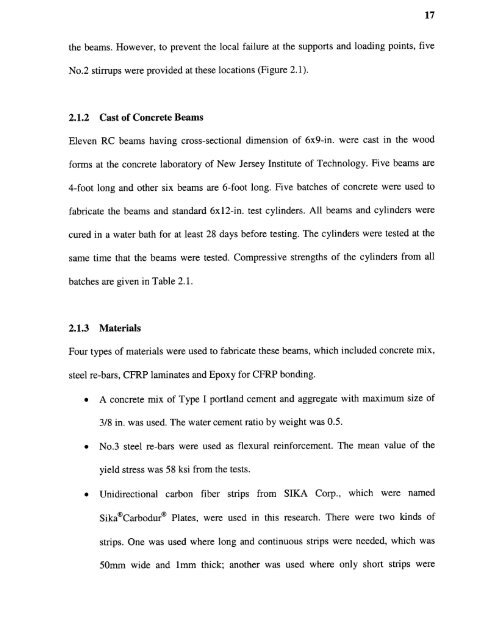njit-etd2003-032 - New Jersey Institute of Technology
njit-etd2003-032 - New Jersey Institute of Technology
njit-etd2003-032 - New Jersey Institute of Technology
You also want an ePaper? Increase the reach of your titles
YUMPU automatically turns print PDFs into web optimized ePapers that Google loves.
17<br />
the beams. However, to prevent the local failure at the supports and loading points, five<br />
No.2 stirrups were provided at these locations (Figure 2.1).<br />
2.1.2 Cast <strong>of</strong> Concrete Beams<br />
Eleven RC beams having cross-sectional dimension <strong>of</strong> 6x9-in. were cast in the wood<br />
forms at the concrete laboratory <strong>of</strong> <strong>New</strong> <strong>Jersey</strong> <strong>Institute</strong> <strong>of</strong> <strong>Technology</strong>. Five beams are<br />
4-foot long and other six beams are 6-foot long. Five batches <strong>of</strong> concrete were used to<br />
fabricate the beams and standard 6x12-in. test cylinders. All beams and cylinders were<br />
cured in a water bath for at least 28 days before testing. The cylinders were tested at the<br />
same time that the beams were tested. Compressive strengths <strong>of</strong> the cylinders from all<br />
batches are given in Table 2.1.<br />
2.1.3 Materials<br />
Four types <strong>of</strong> materials were used to fabricate these beams, which included concrete mix,<br />
steel re-bars, CFRP laminates and Epoxy for CFRP bonding.<br />
• A concrete mix <strong>of</strong> Type I portland cement and aggregate with maximum size <strong>of</strong><br />
3i8 in. was used. The water cement ratio by weight was O.5.<br />
• No.3 steel re-bars were used as flexural reinforcement. The mean value <strong>of</strong> the<br />
yield stress was 58 ksi from the tests.<br />
• Unidirectional carbon fiber strips from S1KA Corp., which were named<br />
Sika®Carbodur® Plates, were used in this research. There were two kinds <strong>of</strong><br />
strips. One was used where long and continuous strips were needed, which was<br />
5Omm wide and lmm thick; another was used where only short strips were

















